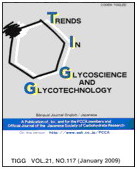All issues

Volume 22, Issue 123
Displaying 1-6 of 6 articles from this issue
- |<
- <
- 1
- >
- >|
MINIREVIEW
-
Luis Bohé, David CrichArticle type: MINIREVIEW
2010Volume 22Issue 123 Pages 1-15
Published: 2010
Released on J-STAGE: June 10, 2010
JOURNAL FREE ACCESSGlycosylation is a process involving the union of two chiral partners, a donor and an acceptor, and is therefore formally subject to double diastereodifferentiation.In this review, we discuss, through the presentation of suitable examples, double diastereoselection in glycosylation reactions based on the “matched and mismatched concept”. We also discuss the related but more widely appreciated concept of regioselective glycosylation of diols and illustrate through select examples how this may vary on the basis of donor and even promoter.Finally, we diverge from the usual course of representation of glycosylation stereoselectivity as a simple ratio, and also represent it in terms of diastereomeric excess to facilitate comparison with other branches of organic chemistry.View full abstractDownload PDF (1057K) -
Yoshiyuki Manabe, Sho Inomata, Minoru UedaArticle type: MINIREVIEW
2010Volume 22Issue 123 Pages 16-25
Published: 2010
Released on J-STAGE: June 10, 2010
JOURNAL FREE ACCESSLeguminous plants open their leaves during the day and close them at night as if sleeping, a type of movement that follows circadian rhythms and is known as nyctinastic movement. This phenomenon is controlled by two endogenous bioactive substances that exhibit opposing activities: Leaf-Opening Factor (LOF), which opens the leaves, and Leaf-Closing Factor (LCF), which closes them. The authors have carried out chemical biological research using these bioactive substances in order to clarify the mechanisms of nyctinastic movement. Here, we report on the detection and identification of the target proteins of these compounds using original methodology.View full abstractDownload PDF (1579K) -
Hisanori Nambu, Seiichi Nakamura, Noritoshi Suzuki, Shunichi HashimotoArticle type: MINIREVIEW
2010Volume 22Issue 123 Pages 26-40
Published: 2010
Released on J-STAGE: June 10, 2010
JOURNAL FREE ACCESSThe development of a general stereoselective method for 1,2-cis-α-glycosidations remains an important issue for synthesis in carbohydrate chemistry. Recently, we have achieved a highly stereocontrolled construction of 1,2-cis-α-glycosidic linkages using glycosyl diphenyl phosphates as glycosyl donors. The per-O-benzyl-protected glucosyl and galactosyl donors and the 3,4,6-tri-O-acetyl-2-azido-2-deoxygalactosyl donor each react with a range of acceptor alcohols in the presence of 0.05–0.2 equiv of HClO4 in dioxane/Et2O (1:1) to afford glycosides in good yields with good to high α-selectivities. The synthetic utility of the present glycosidation method was demonstrated by a stereoselective synthesis of the α-galactosylceramide KRN7000, an activator of natural killer (NK) T cells through CD1d molecules.View full abstractDownload PDF (1066K)
GLYCOTOPIC
-
Masafumi HidakaArticle type: GLYCOTOPIC
2010Volume 22Issue 123 Pages 41-44
Published: 2010
Released on J-STAGE: June 10, 2010
JOURNAL FREE ACCESSDownload PDF (307K) -
Akihiro IshiwataArticle type: GLYCOTOPIC
2010Volume 22Issue 123 Pages 45-47
Published: 2010
Released on J-STAGE: June 10, 2010
JOURNAL FREE ACCESSDownload PDF (289K) -
Katsunori TanakaArticle type: GLYCOTOPIC
2010Volume 22Issue 123 Pages 48-50
Published: 2010
Released on J-STAGE: June 10, 2010
JOURNAL FREE ACCESSDownload PDF (330K)
- |<
- <
- 1
- >
- >|